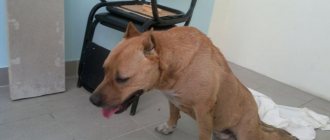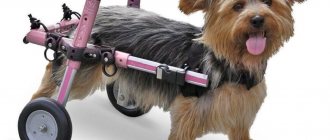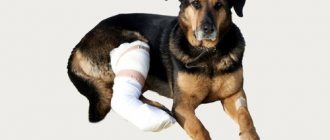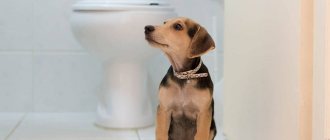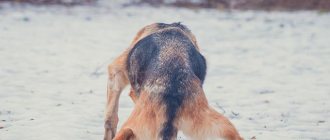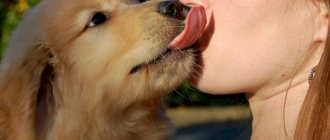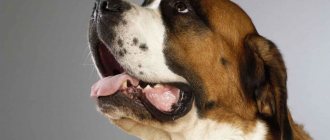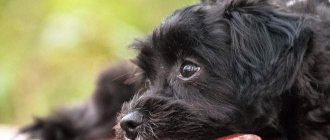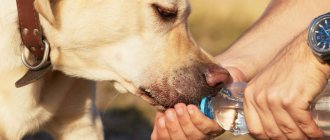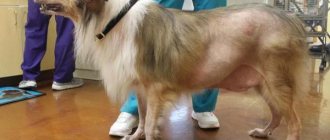Lameness in dogs is one of the most common problems caused by changes in gait due to gait dysfunction in one or more limbs. Usually this can be immediately detected, since the animal presses the sore paw, or leans only partially on it, redistributing the weight to healthy limbs. This is explained by the fact that the animal is trying to avoid pain when putting pressure on the sore paw, so it unconsciously tightens it and does not use it when walking. Lameness in a dog can be either a harmless phenomenon caused by a minor injury or a symptom of severe injury or a serious illness.
Dog lameness on the front leg
Lameness of the supporting limb is more common in dogs, since the front supporting legs are susceptible to various injuries. Jumping will pose the greatest danger, as the dog can twist a paw, sprain a ligament, or dislocate a limb if it lands poorly or encounters obstacles. Also dangerous will be slippery floors in the house, when the dog can simply slip and injure its paw, as well as shards of glass on the road and other sharp elements, when stepped on, the dog can cut the skin or get very seriously cut.
Thus, the front paws are more likely to be affected since they are the first paws the dog lands on. Jumping onto an uneven surface can cause dogs to become lame on the front leg, which can result in external injuries such as cuts and bruises, or internal injuries such as sprains and fractures. Another cause of damage and lameness in a dog's front leg is the ability to open doors inside the house or cabinet doors. When trying to pry on various objects, the dog may pinch its front paw, injure a finger, or tear off a claw.
Types of lameness
There are 4 types of lameness:
- Leaning limb - the animal leans on its paw, but does not do it completely, leaning on a healthy limb and trying to quickly transfer weight to it. The stride of the affected paw becomes shorter. It is observed mainly in chronic processes and minor injuries. Tumors and arthrosis are characterized by the appearance of mild lameness, which progresses over time. Lameness in a dog's front leg can be observed due to elbow dysplasia.
- Hanging limb - the dog does not rest on its paw, but tucks it in, the limb constantly hangs in the air. Such lameness is typical for acute inflammation, dislocations of joints in dogs, fractures, and ligament ruptures. Lameness of the supporting and hanging limb can periodically change from one type to another.
- Intermittent - the dog's lameness goes away for a while, then occurs again. Often this is lameness of the supporting limb. Characteristic of the initial stage of joint dysplasia, osteochondrosis, and metabolic disorders. In case of chronic pathologies of the joints, it can occur after the dog stands on its paws, gradually disappearing during a walk. Intermittent hind leg claudication in small breed dogs is often caused by medial luxation of the patella or Perthes syndrome.
- A stiff gait - the dog seems to be protecting its sore paw. Often occurs with neurological disorders, when the characteristic muscle overstrain, causing a stiff gait, or excessive relaxation, in which the animal pulls up its paw. Sensitivity is reduced.
First harbingers
The first warning sign is abnormal movements of the pet, tremors, uncertainty appear in its legs, and sometimes there is lameness..
The second manifestation is pain. This can manifest itself in different ways: the pet can whine, hide, demand the owner’s attention, while the dog becomes lethargic and inactive.
A little later, weakness appears in the limbs and only then paralysis occurs.
It can take several days to several weeks between the appearance of the first symptoms and complete limb failure.
Degrees of lameness
Lameness in dogs can also be classified according to the severity of the disease, how painful the lameness is and what pathological processes occur in the dysfunction of the limbs, different degrees of lameness are distinguished.
Usually there are three degrees: weak first degree, moderate second and strong third degree.
The first degree is a mild lameness, in which the animal can briefly lean on the sore paw and transfer its weight to it, or there is an arrhythmia in the movement of the sore paw. The animal seems to protect its paw and tries to use it for a minimum amount of time so as not to further injure it.
The second medium degree is observed when partial support is placed on the sore paw or when it is brought forward. Using the paw is already difficult for the animal, and the dog tries to press in or bring forward the sore limb.
The third, most severe degree of lameness is characterized by non-use of the affected limb; when walking, the animal cannot rest on the affected leg at all and has difficulty moving it. Movement will be very difficult, and painful symptoms require immediate assistance to the pet.
Causes of lameness in dogs
Common causes of lameness in dogs:
- Injuries - blows, bites, falls and other mechanical factors leading to bruises, fractures, ruptures of muscles and ligaments, dislocations of joints. Claw injuries.
- Inflammatory and degenerative diseases of the musculoskeletal system.
- Pathologies of the spinal cord and peripheral nerves, leading to spasms, paresis and paralysis.
- Tumor processes.
- Shortening of the limb due to old fractures, joint pathologies.
- Thrombosis of large vessels of the extremities.
- Genetic diseases – Legg-Calvé-Perthes disease, hip and knee dysplasia.
- Frostbite, burns, contact with chemically active substances.
- Excess weight, too rapid weight gain in large breed puppies.
- Diseases of internal organs accompanied by severe pain. With liver diseases, the animal may limp on the right thoracic limb, with cardiac pathologies - on the left thoracic limb, with kidney diseases, stiffness of the hind legs is very often observed.
- Metabolic disorders - vitamin deficiencies, alimentary hyperparathyroidism, lack of calcium in the diet.
The main sign of intermittent claudication in a dog is that it occurs periodically, so it can be noticed while the animal is moving. Lameness will depend on the speed and pace at which the animal moves, for example, during slow walking lameness may not appear, but after jumping or sudden movements, the animal will begin to experience pain again. Most often manifests itself in supporting limbs.
The hanging type of lameness in dogs is characterized by partial movement of the wounded paw forward or lifting it, as if pressing the paw in the air while walking. In this case, the animal cannot lean on the wounded paw; this type can be easily noticed when walking due to the tucked front paw; you can also notice a decrease in the length of the step. These symptoms indicate various severe dislocations and fractures, or acute inflammation, when the dog cannot use its paw at all.
The mixed type of lameness in dogs is so named because it contains a “mixing” of two dysfunctions of the limbs at once, that is, both support and extension. The animal experiences pain while resting on its paw, and also cannot move the limb, since the extension phase will be complicated due to inflammation, dislocations or other damage to the joints.
What to do at home?
The main thing is to create a comfortable environment for your pet. Do not forget that any measures taken at home are discussed in advance with a veterinarian and are taken only after diagnosis and general treatment of the disease in the clinic!
At home, the dog should have a warm, soft place (preferably a bed), free access to clean drinking water and good nutrition. These measures will help the animal’s body, weakened due to the disease, recover much faster and overcome myositis without health consequences.
At home, continue to follow all the veterinarian’s recommendations (give medications as prescribed, apply special compresses, visit the clinic in a timely manner for examinations and adjustments to prescriptions, etc.).
At home, you need to provide your pet with proper nutrition. A prerequisite is compliance with the drinking regime (water, decoctions). It will allow a weakened body to recover faster from an illness.
Your veterinarian will give you dietary advice at your appointment. Experts usually recommend adding more foods with vitamins A, E and C (vegetable oil, bell peppers, etc.) to your diet. The fact is that they strengthen the immune system and the entire body.
Don't forget about easily digestible proteins. They are found in large quantities in ground beef, chicken and almonds. Another tip is to add foods high in calcium and zinc to your diet (liver, cereals, dairy products).
These useful recommendations will help you not only keep your pet healthy, but also ensure its rapid recovery after suffering from myositis!
Lameness due to infection in dogs
Infectious diseases can cause lameness, as they can affect any system. The infection can affect several limbs at once; a characteristic sign of lameness during infection in dogs is the intermittent type, when the animal seems to move from one diseased paw to another, and cannot lean on several limbs at once. The injury rarely results in damage to more than two limbs. Therefore, if an animal experiences pain and lameness in each paw, this may indicate infectious pathologies, but this can also be noticed by numerous other symptoms of malaise.
Also, if the cause of lameness is infection or inflammation, then these diseases can occur with an increase in temperature by a couple of degrees to 40-41 C.
Symptoms
Some dogs' paws give out overnight, while for others it can take a very long time before a person notices something is wrong. Unfortunately, the symptoms of this are not always clearly visible; much depends on the cause of the disease.
The most important symptom is pain, which, by the way, is not always clearly expressed. At the very beginning of development, some may, due to pain in the back of the body, begin to wobble with their backside. This is clearly noticeable while walking. Also, sometimes pain can occur after heavy physical activity or active games.
Often the pain syndrome is pronounced, and the dog not only cannot walk normally, but even falls to the ground and tries to get up. She cannot do this, which is why she suffers and panics. In some cases, after rest, the animal can move again, but sometimes the dog can be deprived of legs for a long time.
It is because of the pain that the dog develops weakness in its hind legs and cannot stand confidently. There can be no talk of jumping and fast running at all. You can often observe that the dog not only changes its gait, but also begins to tangle its paws.
The worst symptom is numbness in the paws; the dog cannot move them. This means that paresis or paralysis has occurred and immediate treatment is needed.
Diagnostics
If lameness appears, you should immediately consult a doctor to determine what caused the pathology. First, the doctor will ask you to walk your dog for a few minutes in front of the clinic or walk around the office so that he can assess the nature of the lameness. Sometimes you need to go for a run with the dog, or go up or down the stairs.
Then they examine the sore paw for damage, palpation, functional tests - flexion and extension, twisting, stretching, compression, and so on. This will help determine the location of the problem, the condition of the bones, joints, muscles and ligaments.
Then an X-ray of the affected area is taken, and, if necessary, a computed tomography or magnetic resonance imaging scan is performed. Sometimes additional studies are needed - arthroscopy, joint puncture, histological examination, blood test, ultrasound.
Lameness in dogs treatment
Treatment is primarily aimed at eliminating the underlying pathology that caused the lameness, providing pain relief and restoring limb function. This may include:
- The use of steroidal and non-steroidal anti-inflammatory drugs, decongestants, chondroprotectors, antibiotics, compresses with painkillers and anti-inflammatory drugs.
- Surgical intervention - wound suturing, osteosynthesis, arthroplasty, tumor removal, endoprosthetics, injection of drugs into the joint cavity.
- Treatment of concomitant diseases of internal organs.
- Physiotherapy, massage, performing special exercises to strengthen the musculoskeletal system.
- Normalization of nutrition, prescription of vitamin and mineral supplements.
Treatment for intermittent claudication will depend on what pathology is causing the limb dysfunction. Accordingly, treatment should eliminate this cause and facilitate the animal’s movements.
Be sure to contact the nearest veterinary clinic for specialist advice, since only a competent doctor, based on the results of the examination and tests, can say what exactly caused the lameness.
Small breeds of dogs are more likely to suffer from this type, as they often experience a dislocation of the kneecap: this does not cause great difficulty or pain, however, it can lead to a worsening of the condition after some time.
How to avoid problems during puppyhood?
For maximum effectiveness, preventative measures begin to be taken as early as puppyhood.
Prevention measures:
- The use of chondroprotective drugs for prevention purposes.
- Ban on playing with large dogs.
- From time to time, X-ray diagnostics should be performed so as not to miss the onset of the disease.
- The puppy must have moderate physical activity.
- The puppy's diet must be balanced. During puppyhood, it is very beneficial to give your Labrador food for young dogs.
- Separately, you should give your dog vitamins and supplements with microelements.
Prevention
Any owner would like to protect their pet from all kinds of injuries, but daily walks and everyday situations can be associated with the risk of injury. Therefore, for prevention, the following rules should be observed.
To prevent lameness, the animal should be provided with a balanced diet and normal physical activity. It is necessary to examine the dog by a veterinarian every year; animals at risk - every 6 months. The latter include puppies, older dogs, representatives of giant and dwarf breeds.
The animal should not be allowed to play with significantly larger dogs, as this can result in serious injuries. After walks, you need to carefully examine your paws for splinters, wounds, cracks in the pads, and damage to the claws. Self-administration of painkillers before consulting a doctor is strictly prohibited. It is important to first determine the cause of lameness, and only then move on to eliminating the symptom itself.
Care and nutrition
During treatment, the four-legged pet must be placed in the most comfortable conditions. The new sleeping place should be located away from sources of noise, drafts and low temperatures. You will also need to limit your usual activity and review your diet.
Physical exercise
Any exercises on apparatus, running and jumping are prohibited. To control weight and maintain mobility, it is enough to take your dog for daily walks lasting 10-15 minutes. Longer activity is encouraged only in relation to swimming. In water, the load is distributed evenly, eliminating new injuries.
Diet
During treatment, the patient is put on a low-carbohydrate diet. Its main task is to maintain or reduce weight to a safe level.
When dry feeding, it is recommended to switch to food with chondroprotectors, and when using natural feeding, add to the menu:
- brisket;
- greens;
- ginger;
- oranges;
- avocado;
- cartilage;
- spatula;
- yolks;
- sunflower seeds;
- mango.
All exotic products must be introduced gradually to avoid an allergic reaction. Vegetables (broccoli, carrots, celery) and fruits should make up the majority of your diet. You should avoid cereals, eggplants, peppers, potatoes and tomatoes, as they can cause a new exacerbation.
